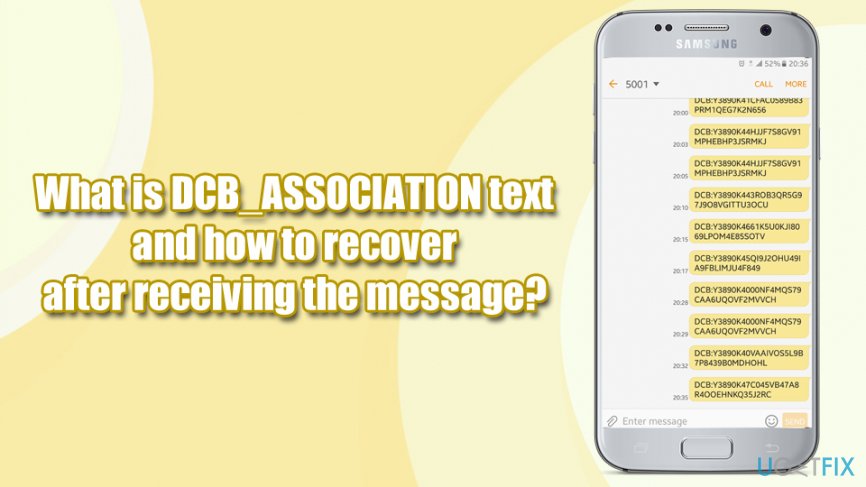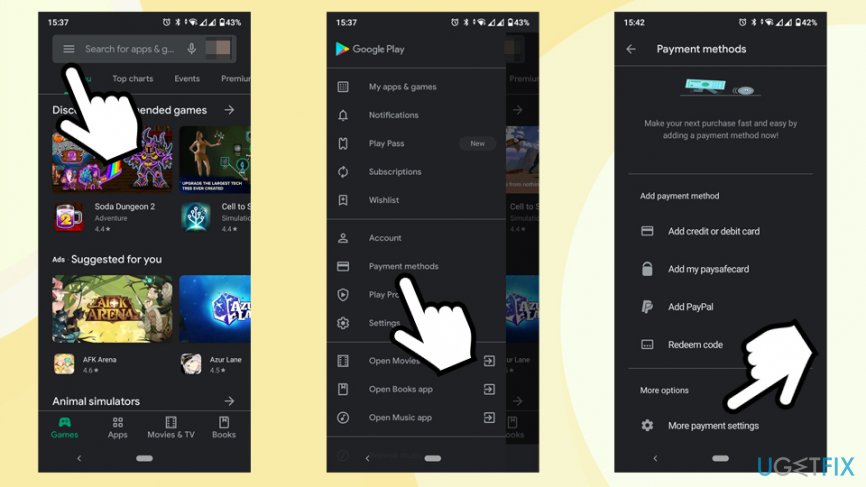Question
Issue: What is DCB_ASSOCIATION text and how to recover after receiving the message?
Hello, I have received a message that says the following “DCB_ASSOCIATION: 149427a0982c12478497b8a”. I have no clue what triggered this message – is it a scam? Do I need to do anything after receiving this SMS? Please help.
Solved Answer
DCB_ASSOCIATION text has been a mystery to many users for years, as they do not understand why are the messages coming to their Android phones or what do they mean. Additionally, the SMS usually comes from a short number like 6759 or 7133 without any indication of who the sender is.
Mobile devices have become one of the most important parts of any modern-day individual's lives, as phones are used not only for talking to colleagues, family and friends but also for gaming, texting, drawing, carrying out payments, and much, much more. Essentially, phones are now mini-computers that possess a large amount of CPU power and are actually more powerful than some desktop or laptop computers.[1]
Nevertheless, smartphones have been used by malicious actors to carry out scams for a while now, and users keep receiving messages with false claims or asking them to click on malicious links that download malware,[2] direct to spoofing[3] sites, or ask for credit card information. Thus, it is not surprising that people would question an unsolicited message from a short number, which includes DCB_ASSOCIATION plus some random text.

Therefore, what is DCB_ASSOCIATION text, and what to do once you receive it? Well, the good news is that it is definitely not a scam, and is coming from a legitimate source. Users receive a text from a short number (four digits) with the following text:
- DCB_ASSOCIATION:Y35810KLQRRF6D4H9D9Q4FRTGM
- DCB_ASSOCIATION:PB23CF051C8536D53CD34EAD, or similar.
DCB_ASSOCIATION stands for “Direct Carrier Billing” and is a simple online receipt that users receive from Google Play Store after performing a transaction on the market. Users can set up their mobile carrier (such as Verizon, AT&T, Vodafone, T-Mobile, and many others) accounts to be billed instead of their credit cards directly – it is a common and effective way to perform purchases via the Store. Therefore, DCB_ASSOCIATION messages only come to Google Play users, i.e., Android devices.
Once a purchase is made via the mobile provider, Google Play sends a message to the carrier using a specific code that is only related to that particular carrier that includes the text “DCB_ASSOCIATION:[authentication_ID].” This message helps the carrier to identify multiple things that must correlate with each other, such as the phone number, the request ID, and Google account belonging to the correct parties.
Based on all the received parameters, the carrier can authorize the transaction, which results in users receiving a brief DCB_ASSOCIATION text. In other words, it is a simple confirmation that the transaction was made via Google Play account and that it will be billed via the carrier.
Thus, if you have enabled your carrier as a payment method for your transactions on Google Play Store, DCB_ASSOCIATION text is legitimate, and you should not be worried about receiving it. However, you should also be aware that certain hacks or malware infections might allow malicious actors to perform transactions via Google Play without your approval.
In such a case, you could and should be worried about DCB_ASSOCIATION prompts. The best action would be to change your Google password immediately and contact your carrier, explaining about the unsolicited transactions coming from your account – you will most likely be refunded.
If you want to stop DCB_ASSOCIATION texts from coming your way and want to remove your payment method via the Google Play Store, follow the instructions provided below.
Remove DCB_ASSOCIATION payment method via Google Play Store
Regardless if the purchases via the Google Play Store are performed legitimately or not, you can make effort to stop the payment method to be functional if you desire to do so. Here is what you need to do:
- Tap your Google Play Store button to open the app
- Select the menu located at the top-left corner (three horizontal lines)
- Pick Payment methods
- At the bottom of the menu, pick More payment settings

- Your browser will open and you will be directed to Google payment center
- In here, tap on the Remove button next to your provider (Verizon, AT&T, or other) or a credit card entered earlier
Recover files and other system components automatically
To recover your files and other system components, you can use free guides by ugetfix.com experts. However, if you feel that you are not experienced enough to implement the whole recovery process yourself, we recommend using recovery solutions listed below. We have tested each of these programs and their effectiveness for you, so all you need to do is to let these tools do all the work.
Protect your online privacy with a VPN client
A VPN is crucial when it comes to user privacy. Online trackers such as cookies can not only be used by social media platforms and other websites but also your Internet Service Provider and the government. Even if you apply the most secure settings via your web browser, you can still be tracked via apps that are connected to the internet. Besides, privacy-focused browsers like Tor is are not an optimal choice due to diminished connection speeds. The best solution for your ultimate privacy is Private Internet Access – be anonymous and secure online.
Data recovery tools can prevent permanent file loss
Data recovery software is one of the options that could help you recover your files. Once you delete a file, it does not vanish into thin air – it remains on your system as long as no new data is written on top of it. Data Recovery Pro is recovery software that searchers for working copies of deleted files within your hard drive. By using the tool, you can prevent loss of valuable documents, school work, personal pictures, and other crucial files.
- ^ Mike Elgan. With smartphones like these, why do we need laptops?. Computerworld. IT news, careers, business technology, reviews.
- ^ Mark Jones. Received a strange text? Whatever you do, don’t click the link!. KimKomando. Tech site.
- ^ Website spoofing. Wikipedia. The free encyclopedia.




